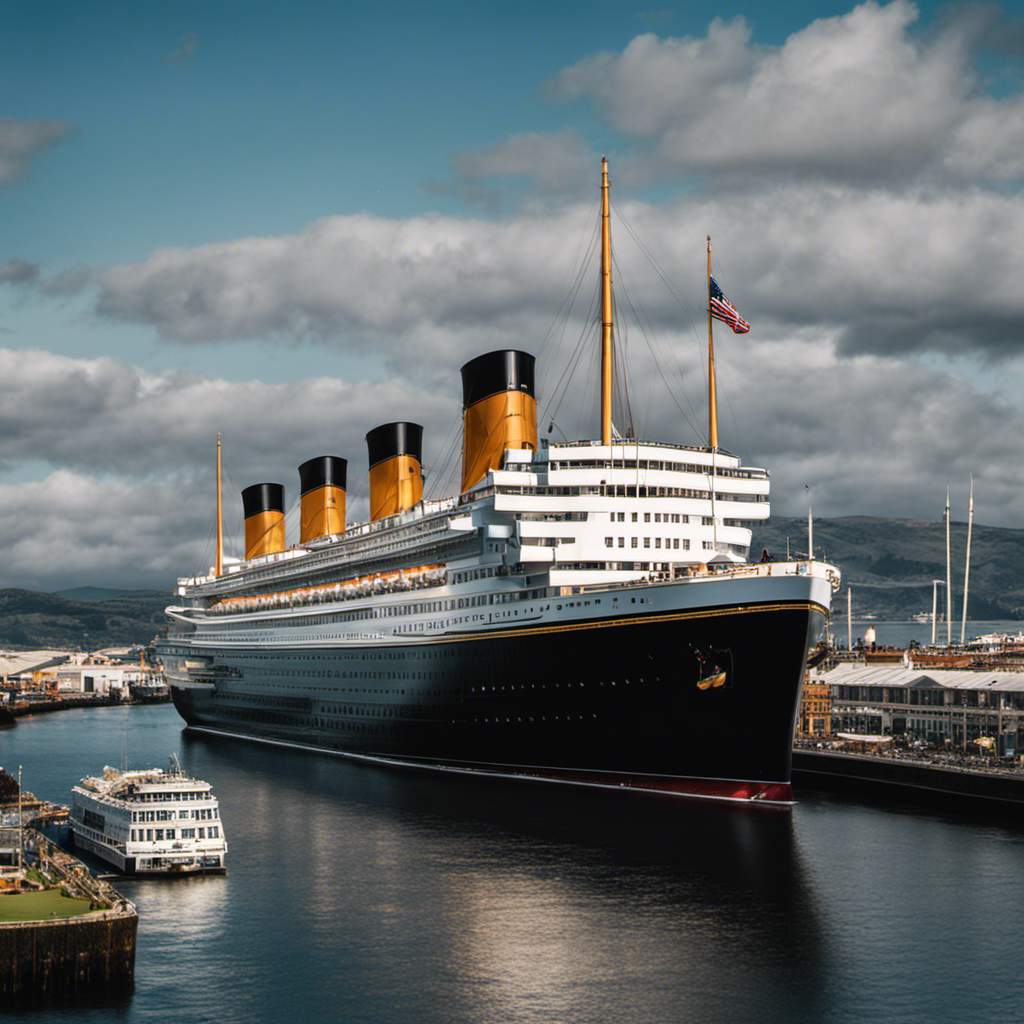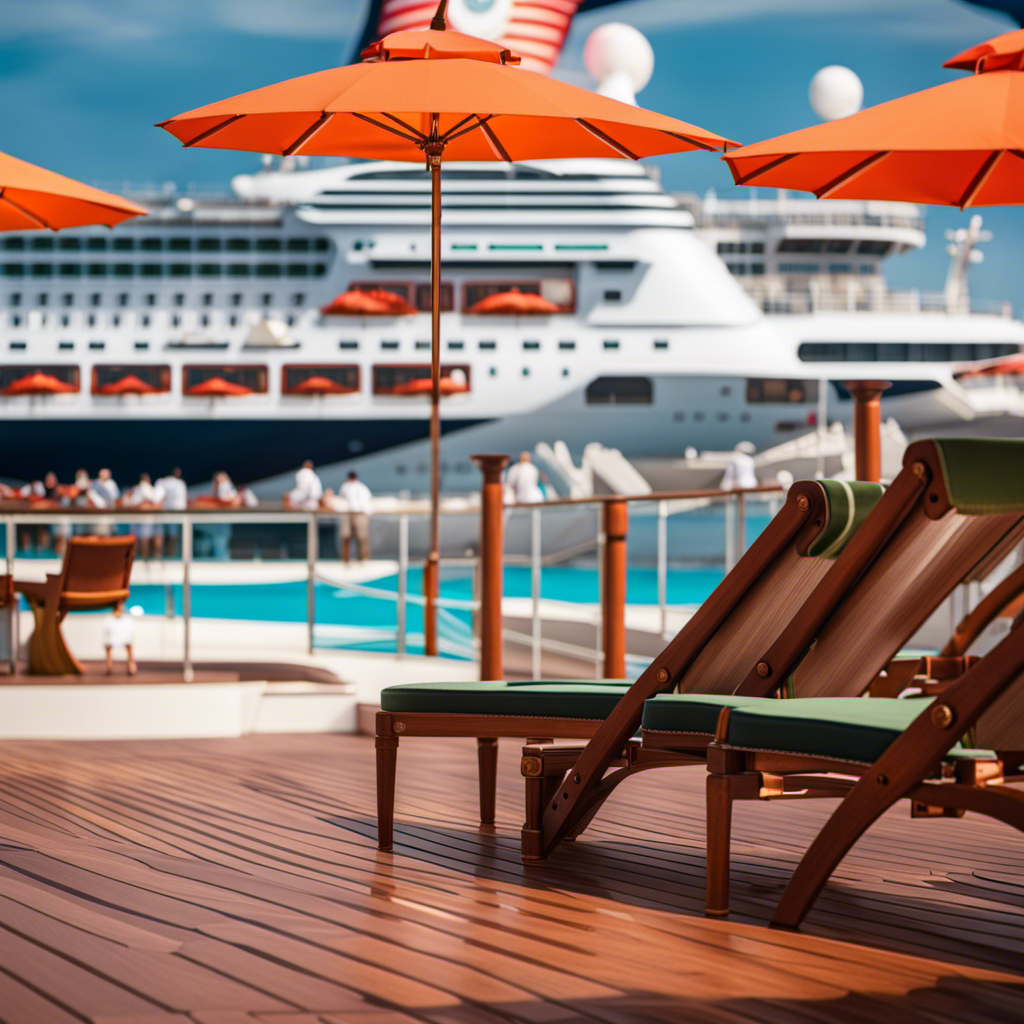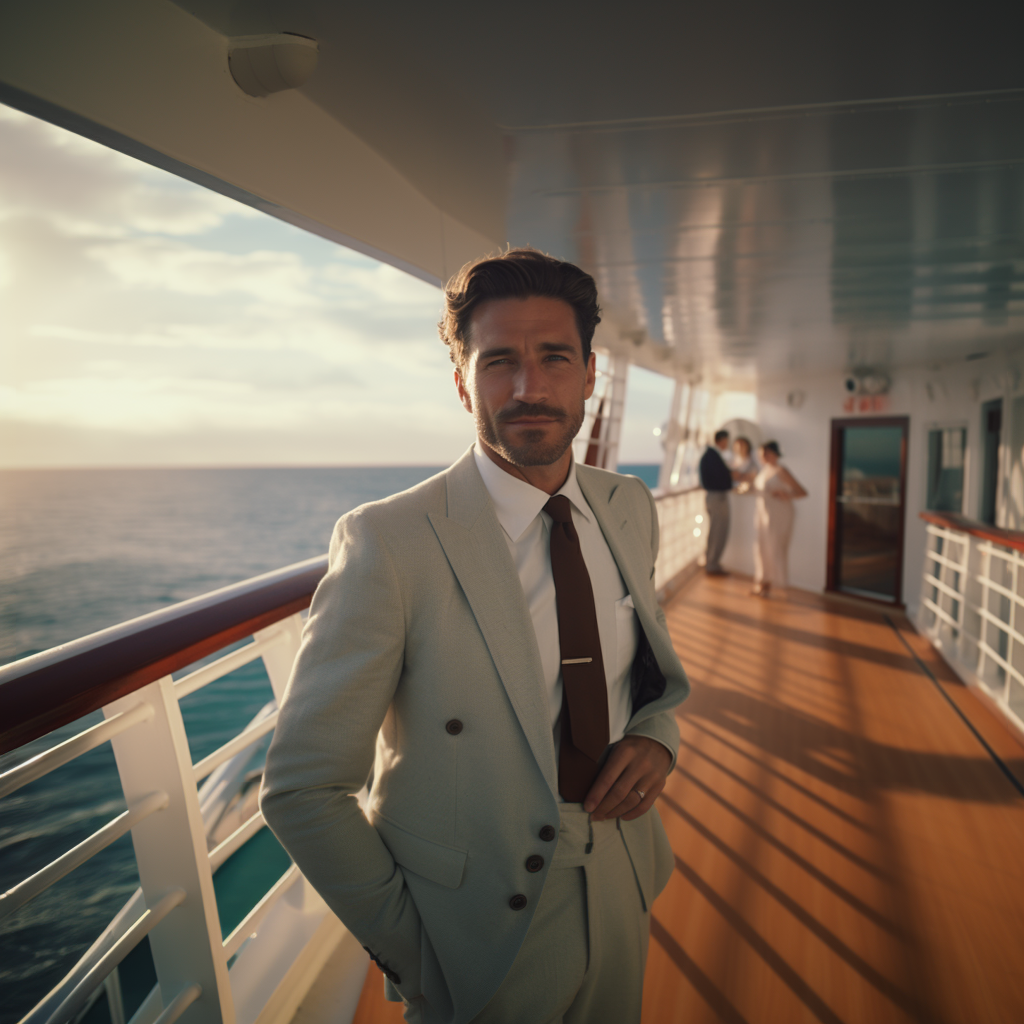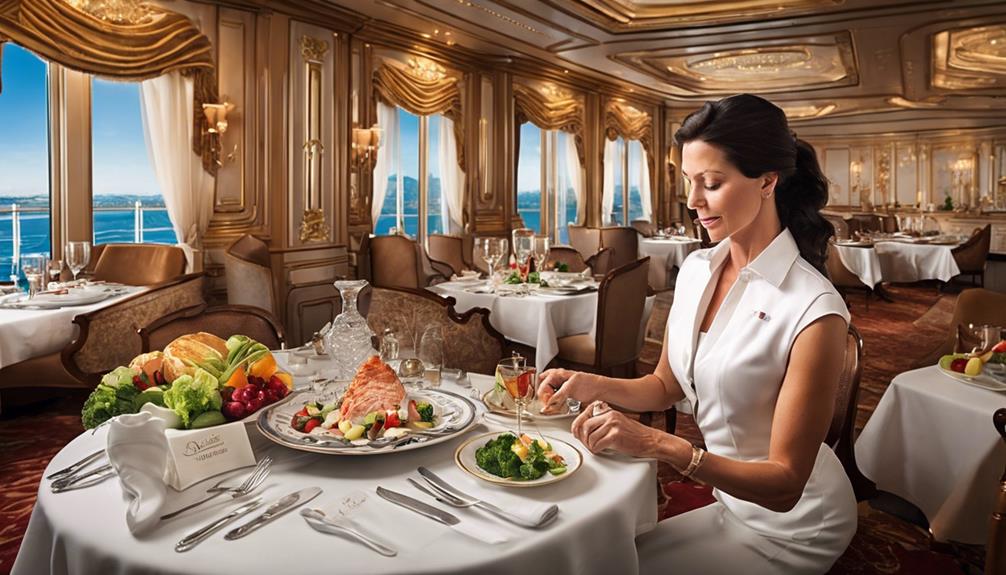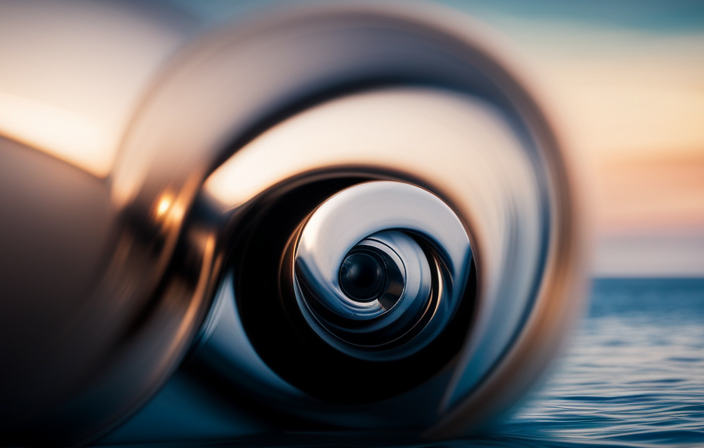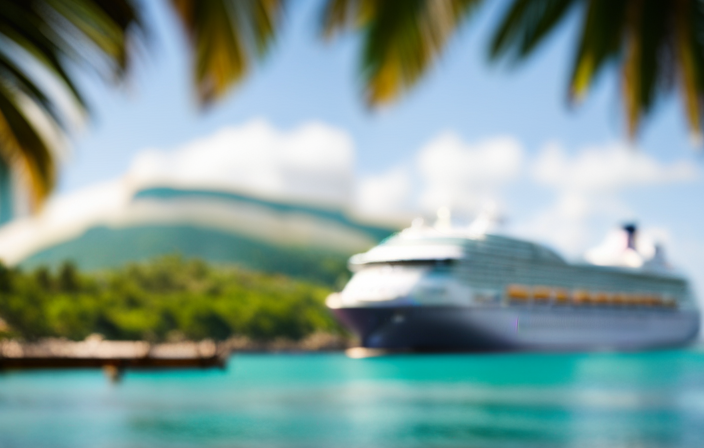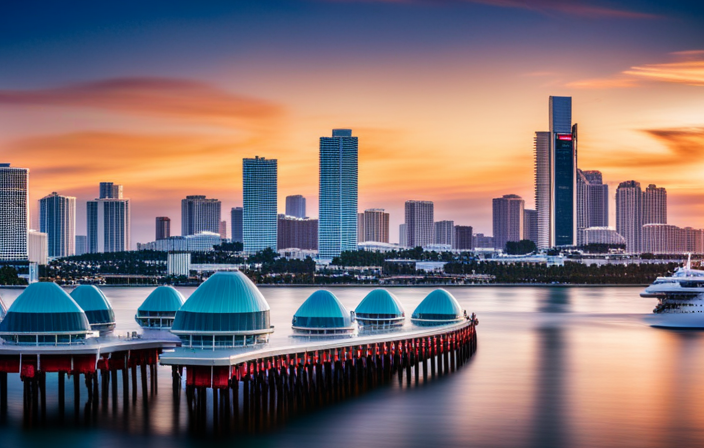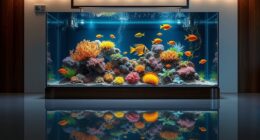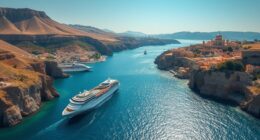Every time I think of the Titanic, I’m unavoidably led to picture its vast magnificence and size. Understanding the true enormity of this iconic vessel proves difficult, especially when compared to today’s modern cruise ships.
In this article, we will delve into the historical context and explore the incredible size of the Titanic in relation to its contemporary counterparts. Prepare to be amazed as we uncover the fascinating details of this legendary ship and its place in maritime history.
Key Takeaways
- The Titanic represented a significant milestone in ship design, but modern cruise ships have surpassed it in size and technology.
- Modern cruise ships can reach lengths of over 1,100 feet, compared to the Titanic’s length of 882 feet.
- Modern cruise ships have a wider width, ranging from 100 to 230 feet, providing passengers with a more luxurious and comfortable experience.
- Modern cruise ships can accommodate up to 6,000+ passengers, while the Titanic could accommodate over 2,400 individuals.
Historical Context: The Titanic’s Size in Perspective
The Titanic was huge, but it is tiny compared to modern cruise ships. When considering the historical context of the Titanic’s size, it is important to understand the evolution of shipbuilding techniques and their impact on maritime history.
The Titanic, with its length of 882 feet and gross tonnage of 46,328, represented a significant milestone in ship design during its time. However, advancements in shipbuilding since then have led to the creation of much larger and more technologically advanced cruise ships. These modern giants can reach lengths of over 1,100 feet and have gross tonnages surpassing 225,000.
This exponential growth in size has revolutionized the cruise industry, allowing for more amenities, entertainment options, and an overall enhanced experience for passengers. As we delve into the topic of length and compare the Titanic’s size to modern cruise ships, we will gain further insight into the magnitude of this evolution.
Length: Comparing the Titanic’s Length to Modern Cruise Ships
When comparing the lengths of the Titanic and modern cruise ships, it’s evident that there has been a significant evolution in size.
The Titanic, with a length of 882 feet, was considered a marvel of engineering during its time. However, modern cruise ships have surpassed this length by a wide margin, with some measuring over 1,100 feet long.
This increase in size has had a profound impact on the travel experience. It allows for more amenities, activities, and accommodations on board.
Titanic Vs. Modern Lengths
Compared to modern cruise ships, the Titanic is much smaller in length. At approximately 882 feet long, the Titanic was considered a marvel of engineering during its time. However, as the years have passed, shipbuilding techniques and technologies have evolved, resulting in much larger cruise ships today.
The evolution of shipbuilding has had a significant impact on the maritime industry. The ability to construct larger vessels has allowed for increased passenger capacity, improved amenities, and enhanced onboard experiences. These advancements have greatly influenced the cruise industry’s growth and profitability.
As shipbuilders continue to push the boundaries of size and design, cruise ships have become even larger and more luxurious. This evolution of cruise length has revolutionized the way people travel and experience the open seas.
Evolution of Cruise Length
You can see the evolution of cruise lengths by comparing the sizes of older and newer ships.
Over the years, cruise ships have undergone significant changes in size and design, leading to the evolution of cruise amenities and the impact of size on the passenger experience.
In the early days of cruising, ships were much smaller, with limited onboard facilities and activities. However, as technology advanced and the demand for luxurious experiences grew, cruise ships became larger and more extravagant.
Today, modern cruise ships are like floating cities, offering a wide range of amenities such as multiple restaurants, theaters, swimming pools, spas, and even amusement parks. The size of these ships allows for a more diverse and immersive experience, with something for everyone.
This transition from smaller to larger ships has had a profound impact on the way people travel, as it has opened up a world of possibilities for passengers to explore and enjoy.
Size Impact on Travel
The impact of size on travel can be seen in the diverse range of amenities and experiences offered on modern cruise ships. The size of a cruise ship has a significant impact on both the cost and the environmental sustainability of the journey.
Here are three ways in which size affects travel:
-
Cost: Larger ships can accommodate more passengers, spreading the cost of operation among a larger number of people. This often results in lower prices for travelers.
-
Amenities: Larger ships have the space to offer a wide array of amenities, including multiple restaurants, pools, theaters, and even shopping malls. This allows passengers to enjoy a luxurious and varied experience during their voyage.
-
Environmental Sustainability: While larger ships consume more fuel and produce more emissions, they also have the capacity to invest in advanced technologies for waste management and energy efficiency. This helps mitigate their environmental impact.
With the understanding of how size impacts travel, let’s now explore how the width of the Titanic stacks up against today’s ships.
Width: How the Titanic’s Width Stacks Up Against Today’s Ships
When it comes to width, the Titanic was significantly narrower than the cruise ships of today. The impact of size on a ship’s capabilities cannot be understated.
The Titanic’s width, measuring at around 92 feet, was considered impressive for its time. However, with the advancements in technology and engineering, modern cruise ships have been able to increase their width significantly.
Today, cruise ships can range anywhere from 100 to 230 feet in width, allowing for more stability and space for amenities. This increase in width has also allowed for more innovative design features, such as larger cabins, expansive decks, and even the inclusion of water parks and amusement rides.
The wider width of modern cruise ships has truly revolutionized the industry, providing passengers with a more luxurious and comfortable experience.
Moving from width to height, the Titanic’s impressive height compared to modern vessels is another aspect worth exploring.
Height: The Titanic’s Impressive Height Compared to Modern Vessels
Standing tall at a staggering height of 175 feet, the Titanic’s impressive stature remains a testament to the engineering marvels of its time. This grand ship loomed over the waters, showcasing the immense size impact it had on the world of maritime travel.
Here are four remarkable technology innovations that contributed to the Titanic’s remarkable height:
-
Double-Bottom Hull: The Titanic’s double-bottom hull provided enhanced stability and protection against potential damage, allowing it to withstand the immense pressure of the ocean depths.
-
Watertight Compartments: Divided into sixteen watertight compartments, the Titanic boasted the latest technology in shipbuilding. These compartments were designed to prevent flooding in the event of a breach, ensuring the safety of the passengers and crew.
-
Steel Construction: The Titanic was constructed using steel, a revolutionary material that offered unparalleled strength and durability, allowing the ship to reach such impressive heights.
-
Electric Lighting System: Unlike many ships of its time, the Titanic was equipped with an advanced electric lighting system, illuminating its towering structure and providing a sense of luxury to its passengers.
With its towering height and groundbreaking technology innovations, the Titanic set a new standard for the size and capabilities of ocean liners.
Now, let’s delve into the next fascinating aspect of this legendary ship: its passenger capacity, and how many people it could accommodate.
Passenger Capacity: How Many People Could the Titanic Accommodate?
With a capacity of over 2,400 individuals, the Titanic was able to accommodate a large number of passengers during its ill-fated voyage. The ship was designed to provide passenger comfort and luxurious amenities, reflecting the opulence of the time. Despite its tragic end, the Titanic’s impact on the world of maritime travel cannot be overstated. To better understand the scale of the Titanic’s capacity, let’s take a look at a comparison between the Titanic and modern cruise ships:
| Titanic | Modern Cruise Ships | |
|---|---|---|
| Passenger Capacity | Over 2,400 | Up to 6,000+ |
| Length | 882 feet and 9 inches | Up to 1,188 feet |
| Gross Tonnage | 46,328 tons | Up to 228,081 tons |
This table highlights the significant increase in passenger capacity, length, and gross tonnage of modern cruise ships compared to the Titanic. The evolution of these factors demonstrates the continuous effort to enhance passenger comfort and provide a wide range of amenities on board. Transitioning to the subsequent section about ‘amenities: titanic vs. modern cruise ships – what’s on board?’
Amenities: Titanic Vs. Modern Cruise Ships – What’s on Board?
The amenities available on board the Titanic were quite different from those found on modern cruise ships. While modern cruise ships offer a wide range of luxurious amenities to keep passengers entertained and relaxed, the Titanic had a more limited selection.
Onboard entertainment on the Titanic consisted of a gymnasium, a squash court, a swimming pool, and a Turkish bath. Passengers could also enjoy live music in the ship’s grand reception area. However, compared to modern cruise ships, the Titanic’s amenities were relatively modest.
Today, cruise ships boast extravagant features such as water parks, multiple pools, casinos, Broadway-style theaters, and even ice-skating rinks. The advancements in onboard entertainment have made modern cruise ships a popular choice for vacationers seeking a fun and immersive experience.
Speaking of advancements, let’s now explore the technology: Titanic’s innovations in comparison to modern vessels.
Technology: Titanic’s Innovations in Comparison to Modern Vessels
One of the most notable differences between the Titanic and modern vessels is the level of technological innovation.
The Titanic was a marvel of its time, equipped with state-of-the-art features like electric lighting, telegraph communication, and even a sophisticated system of watertight compartments.
These technological advancements had a significant impact on travel, making the Titanic one of the most luxurious and advanced ships of its era.
However, compared to modern vessels, the Titanic’s technological innovations may seem outdated.
Today, cruise ships are equipped with advanced navigation systems, satellite communication, high-speed internet, and even features like on-board theaters and water parks.
The level of comfort and convenience provided by modern technology has revolutionized the travel industry.
Transitioning into the subsequent section about safety measures, it is interesting to compare how the Titanic’s safety features compare to today’s standards.
Safety Measures: How the Titanic’s Safety Features Compare to Today’s Standards
When examining the safety measures of the Titanic, it is evident that they were quite advanced for their time. The ship was equipped with watertight compartments and an advanced wireless communication system.
However, when compared to modern cruise ship standards, it becomes clear that the safety measures on the Titanic were significantly lacking. Today’s cruise ships have extensive safety protocols in place. They include state-of-the-art navigation systems, advanced life-saving equipment, and rigorous training for crew members.
Titanic’s Safety Measures?
Although it had safety measures for its time, the Titanic lacked sufficient lifeboats. The ship was designed to carry a total of 64 lifeboats, which would have been enough to accommodate all passengers and crew. However, due to cost and aesthetics, the Titanic was only equipped with 20 lifeboats, capable of carrying a maximum of 1,178 people. This was woefully inadequate, considering the ship had a capacity of over 2,200 passengers and crew.
Additionally, the Titanic’s watertight compartments, which were supposed to prevent flooding and ensure the ship’s buoyancy in case of an accident, were not designed to withstand the type of damage caused by the iceberg collision. This combination of factors ultimately contributed to the tragic loss of life that occurred that fateful night.
Modern Cruise Ship Standards?
Passengers on modern cruise ships can expect a higher level of safety with stricter regulations and more advanced technology. Here are four ways modern cruise ship design and size impact the overall cruise experience:
-
Enhanced Stability: Larger ships are equipped with advanced stabilizers that minimize the effects of rough seas, providing a smoother ride for passengers.
-
Increased Amenities: Modern cruise ships offer a wide range of amenities due to their larger size. From multiple dining options to expansive spa facilities, there is something for everyone on board.
-
More Entertainment Options: With their increased size, modern cruise ships can accommodate larger theaters, casinos, and even water parks. Passengers have a plethora of entertainment options to choose from throughout the voyage.
-
Better Cabin Options: The size of modern cruise ships allows for a variety of cabin options, from cozy interior staterooms to luxurious suites with balconies. This ensures that passengers can find accommodation that suits their preferences and budget.
Overall, the modern cruise ship design and size have greatly enhanced the cruise experience, providing passengers with increased safety, amenities, entertainment, and cabin options.
Frequently Asked Questions
What Was the Titanic’s Maximum Speed Compared to Modern Cruise Ships?
The Titanic’s maximum speed was around 22 knots, which is slower than modern cruise ships. However, it’s important to note that the Titanic’s fuel consumption and propulsion system were significantly different from those of modern ships.
How Does the Titanic’s Weight Compare to the Weight of Modern Cruise Ships?
The weight of the Titanic compared to modern cruise ships is significant. The Titanic’s weight had a major impact on its stability and maneuverability. Moreover, the historical significance of the Titanic’s weight cannot be understated.
What Was the Cost of Building the Titanic Compared to the Cost of Building Modern Cruise Ships?
The cost of building the Titanic was significantly lower compared to modern cruise ships. The construction time was also longer. However, it’s important to note that the Titanic was built over a century ago, and technology and construction methods have since evolved.
How Long Did It Take to Construct the Titanic Compared to Modern Cruise Ships?
Constructing the Titanic was a monumental feat. Compared to modern cruise ships, it took a considerable amount of time. The construction timeline was plagued with challenges, but the end result was a marvel of engineering.
What Was the Maximum Number of Lifeboats on the Titanic Compared to Modern Cruise Ships?
The maximum number of lifeboats on the Titanic was 20, as per the safety regulations of the time. Compared to modern cruise ships, which are required to have enough lifeboats for all passengers, this was insufficient.
Conclusion
In conclusion, the Titanic was a marvel of its time, but it pales in comparison to the massive cruise ships of today. Its length, width, and height were impressive for its era, but modern vessels have far surpassed its dimensions.
The Titanic could accommodate around 2,435 passengers, which seems like a lot, but today’s cruise ships can hold over 6,000 passengers. The amenities and technology on board modern ships are also far superior.
It’s safe to say that the Titanic was a mere drop in the ocean compared to today’s colossal cruise liners, a true titan of its time.
Alfons is the visionary leader and driving force behind Voyager Info’s success. As the Editor in Chief, he brings a wealth of experience and an unwavering passion for travel to the helm of our cruise-centric platform.
With a lifelong fascination for exploring new horizons, Alfons discovered his love for the ocean and cruising at a young age. From sailing across pristine Caribbean waters to embarking on daring expeditions to far-flung destinations, he has amassed a treasure trove of first-hand experiences in the world of cruising.

